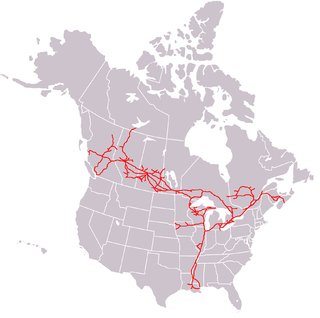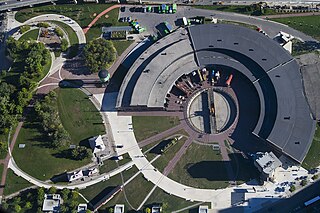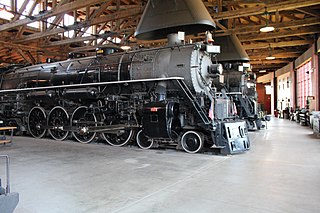
The Canadian Pacific Railway, also known simply as CPR or Canadian Pacific and formerly as CP Rail (1968–1996), was a Canadian Class I railway incorporated in 1881. The railway was owned by Canadian Pacific Railway Limited, which began operations as legal owner in a corporate restructuring in 2001.

The Canadian National Railway Company is a Canadian Class I freight railway headquartered in Montreal, Quebec, which serves Canada and the Midwestern and Southern United States.

Under the Whyte notation for the classification of steam locomotives, 4-8-4 represents the wheel arrangement of four leading wheels on two axles, eight powered and coupled driving wheels on four axles and four trailing wheels on two axles. The type was first used by the Northern Pacific Railway, and initially named the Northern Pacific, but railfans and railroad employees have shortened the name since its introduction. It is most-commonly known as a Northern.

The Prince Edward Island Railway (PEIR) was a historic Canadian railway in Prince Edward Island (PEI). The railway ran tip-to-tip on the island, from Tignish in the west to Elmira in the east, with major spurs serving Borden-Carleton's train ferry dock, the capital in Charlottetown, Montague and Georgetown and the original eastern terminus at Souris. A major spur from Charlottetown served Murray Harbour on the south coast.

The GE U25B is General Electric's first independent entry into the United States domestic road switcher diesel-electric locomotive railroad market for heavy production road locomotives since 1936. From 1940 through 1953, GE participated in a design, production, and marketing consortium (Alco-GE) for diesel-electric locomotives with the American Locomotive Company. In 1956 the GE Universal Series of diesel locomotives was founded for the export market. The U25B was the first attempt at the domestic market since its termination of the consortium agreement with Alco.

The Grand Trunk Western Railroad Company was an American subsidiary of the Grand Trunk Railway, later of the Canadian National Railway operating in Michigan, Illinois, Indiana, and Ohio. Since a corporate restructuring in 1971, the railroad has been under CN's subsidiary holding company, the Grand Trunk Corporation. Grand Trunk Western's routes are part of CN's Michigan Division. Its primary mainline between Chicago and Port Huron, Michigan serves as a connection between railroad interchanges in Chicago and rail lines in eastern Canada and the Northeastern United States. The railroad's extensive trackage in Detroit and across southern Michigan has made it an essential link for the automotive industry as a hauler of parts and automobiles from manufacturing plants.

The Royal Hudsons are a series of semi-streamlined 4-6-4 "Hudson" type steam locomotives formerly owned and operated by the Canadian Pacific Railway (CPR) and built by Montreal Locomotive Works (MLW). The engines were built in 1937. In 1939, King George VI allowed the CPR to use the term after Royal Hudson number 2850 transported the royal train across Canada with no need of replacement. These locomotives were in service between 1937 and 1960. Four of them have been preserved. No. 2839 was used to power excursions for the Southern Railway Steam Program between 1979 and 1980. No. 2860 was used for excursion service in British Columbia between 1974 and 1999, then again between 2006 and 2010.
The Rocky Mountain Rail Society (RMRS) is a registered nonprofit organization of volunteers dedicated to the preservation of Canadian National Railway steam locomotive 6060, The Spirit of Alberta. Their goal is to ensure that The Spirit of Alberta remains in full and complete operating condition for the enjoyment of steam rail fans.

The Toronto Maritime Museum or Toronto Waterfront Museum or The Pier Museum was a museum in Toronto, Ontario, Canada. It celebrated the history of the Toronto waterfront, the history of commerce on the Great Lakes, and the role of maritime commerce in the development of the City of Toronto.

Roundhouse Park is a 17 acre park in the downtown core of Toronto, Ontario, Canada. It is in the former Railway Lands. It features the John Street Roundhouse, a preserved locomotive roundhouse which is home to the Toronto Railway Museum, Steam Whistle Brewing, and the restaurant and entertainment complex The Rec Room. The park is also home to a collection of trains, the former Canadian Pacific Railway Don Station, and the Roundhouse Park Miniature Railway. The park is bounded by Bremner Boulevard, Lower Simcoe Street, Lake Shore Boulevard West/Gardiner Expressway and Rees Street.

Grand Trunk Western 6325 is a class "U-3-b" 4-8-4 "Northern" type steam locomotive built in 1942 by the American Locomotive Company (ALCO) for the Grand Trunk Western Railroad. As a member of the dual service U-3-b class, the 6325 handled heavy passenger and freight work for the Grand Trunk Western. In 1946, the 6325 gained notoriety for pulling United States President Harry S. Truman's election campaign train through the state of Michigan. Retired in 1959, the locomotive was donated for display to the City of Battle Creek, Michigan where a failed restoration attempt left 6325 in danger of being scrapped. Purchased in 1993 by Jerry Jacobson of the Ohio Central Railroad, the locomotive sat in storage for six years until being restored to operating condition on July 31, 2001, for use on excursion trains across the Ohio Central System. The locomotive is in storage, on static display at the Age of Steam Roundhouse in Sugarcreek, Ohio.

Canadian National 6213 is a preserved 4-8-4 steam locomotive on static display in Toronto, Ontario, Canada at the Toronto Railway Museum (TRM) on the lands of the former CPR John St. Roundhouse. It was on active duty until 1959 and was donated by Canadian National Railway (CNR) to the City of Toronto government in 1960. It was on display at Exhibition Place until 2009 when it was moved to its current location.

CN O-18-a is a class of 0-6-0 steam locomotives formerly owned by Canadian National Railways. They were switchers built by the Grand Trunk Railway's Point St. Charles Shops. Canadian National used the letter O to designate 0-6-0s.

The Canadian National U-1-a U-1-b class locomotives were three subclasses of 37 4-8-2 Mountain-type steam locomotives built for the Canadian National Railways between 1923 and 1924. They were retired between 1951 and 1962.

Grand Trunk Western No. 6039 is a preserved class "U-1-c" 4-8-2 "Mountain type" steam locomotive built in June 1925 by Baldwin. It served the Grand Trunk Western Railroad by pulling fast passenger and freight trains throughout the Lower Peninsula of Michigan, until the railroad decided to dieselize their locomotive fleet. During that time, it was leased to the Central Vermont Railway for freight service, only to become one of the very last steam locomotives to regularly operate in the state of Vermont. After being retired in the late 1950s, No. 6039 became one of the very first steam locomotives to be owned by F. Nelson Blount, and it subsequently became part of his Steamtown, U.S.A. collection for static display. In 1984, the locomotive was moved along with every other locomotive in the Steamtown collection from Bellows Falls to Scranton, Pennsylvania, where the name would late be changed to Steamtown National Historic Site under the jurisdiction of the National Park Service. As of 2023, No. 6039 remains on static display at Scranton with very meticulous cosmetic care.

Grand Trunk Western No. 6323 is a preserved class "U-3-b" 4-8-4 "Northern" type steam locomotive built by Alco in 1942. It served the Grand Trunk Western Railroad by pulling various heavy freight and passenger trains across the Lower Peninsula of Michigan and Northern Indiana. It became famous in later years for being the very last active steam locomotive to run on the GTW's trackage while still on the railroad's active list in 1961. After sitting in storage for several years in Detroit, No. 6323 was sold in 1981 to the Illinois Railway Museum, and since then, it has remained on static display in Union, Illinois.

Canadian National 6060 is a 4-8-2 "Mountain"-type steam locomotive built in 1944 by the Montreal Locomotive Works as the first of the U-1-f class for the Canadian National Railway (CN) in Canada. It was first assigned to haul passenger trains and eventually fast freight trains on the CN until its retirement in 1959. Three years later, CN engineer Harry R.J. Home purchased the locomotive for $1 and brought it to his hometown of Jasper, Alberta, where No. 6060 was put on display near the Jasper station.

Canadian National Railway No. 6400 is a preserved 4-8-4 “Confederation” or “Northern” type locomotive built in June 1936 for the Canadian National Railway (CNR).

Canadian National 6218 is a 4-8-4 U-2-g Confederation built by the Montreal Locomotive Works (MLW) in 1942 for the Canadian National Railway. It became famous after it was brought back by CN for their Steam Excursion Program from 1964 to 1971. It is now on static display at the Fort Erie Railway Museum in Fort Erie, Ontario.






















